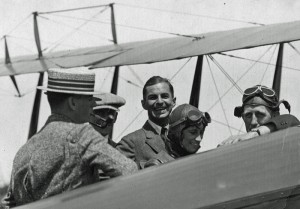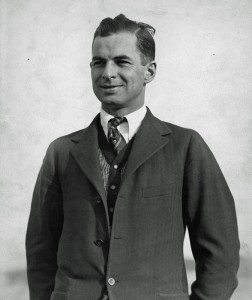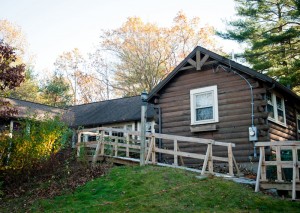True Tales: Things that bugged Quincy Lowry
By George T. ComeauQuincy Shaw Lowry loved bugs. In particular, it was worms and larvae that captured his attention. Early in his career, Lowry studied the Phorbia brassicae Bouche — the cabbage maggot. Becoming an expert in worms and insects would be a lifelong passion for this Canton boy.
Lowry was born in June 1890 to Martin and Rosanna Lowry. As a boy growing up in Ponkapoag at the turn of the last century, Lowry’s life was idyllic and certainly well rooted in agriculture. His family lived at the top of Ponkapoag Hill, quite near the small chapel near the Cabot Estate, now the present-day Eleanor Cabot Bradley Estate. Lowry likely spent parts of his childhood in the fields and meadows surrounding the Great Blue Hill, and his passion for insects was likely formed at an early age.
He graduated from Canton High School in 1908 with a concentration in English studies — one of only 13 graduates, mostly girls, who completed the full course of studies through the Canton Public Schools. In truth, not many students were able to attain a high school diploma, largely due to the fact that they were called upon to work in the mills or fields of Canton. Lowry’s future would be different, however.
The Massachusetts Agricultural College in Amherst was founded in 1863 under the provisions of the Morrill Land-Grant Colleges Act. The mission of Mass. Aggie was to provide instruction to Massachusetts citizens in the “agricultural, mechanical and military arts.” In 1931, Mass. Aggie became Massachusetts State College, and in 1947 it was renamed the University of Massachusetts.
Lowry attended the College of Agriculture, where he found time to manage cross country and follow his passion in agriculture, distinguishing himself with a Bachelor of Science degree. Graduating in 1913, Lowry quickly found a position with the state of Connecticut as an assistant in the Agricultural Extension Station. A postcard to his hometown in July 1913 featured a photograph of Lowry on one side and a note thanking Helen Williams for her “congratulations” likely for his ability to gain employment so quickly after graduation.
Based in New Haven, Lowry’s early work was studying larvae that attacked crops such as cabbage and cauliflower. After two seasons of essentially studying maggots at Mount Carmel, Lowry co-published his findings on how to deal with such pests and greatly assisted the burgeoning science of agricultural studies. By 1916, Lowry was charged with investigating an outbreak of the eight-spotted forester in New Haven that was viciously attacking grape arbors. Such is the exciting life of a state entomologist.
In 1919, Lowry returned to Massachusetts and worked for $4 a day as an assistant nursery inspector. Two years later, in May 1921, he was named the assistant director of the Division of Plant Pest Control in the Massachusetts Department of Agriculture. Working to support the farmers and nurseries of the commonwealth was a great honor for Lowry, and he seemed to love his job. He spent his summers in the western part of Massachusetts where he owned a large log cabin in Shelburne.
Of that place in Shelburne, his sister Ethel once remarked, “It was the most desolate place on earth.” Surrounded by blueberry bushes, Shelburne was a quiet retreat where Lowry could get away and enjoy nature in unspoiled surroundings. Canton friends spent time at his cabin and he recaptured the wilds of his youth in these natural surroundings.
Family members today recall with great affection the life of Quincy Lowry. June (Lowry) Godfrey grew up in Canton and her affection for her “Uncle Quinie” resonated in her voice as she spoke lovingly of a man who was “sporty, laid back, and interesting.”

Lowry (center) prepares for a flight over Ponkapoag in the 1930s. (Courtesy of the Canton Historical Society)
Godfrey graduated from Canton High in 1955 and attended the Chandler School in Boston. On a spring break to Bermuda in her senior year she met her future husband. She was engaged at 22 and Quincy Lowry made sure that the best flowers were arranged for the wedding of his beloved niece. “He loved flowers and the gerberas matched the aqua bridesmaids’ dresses perfectly,” explained Godfrey, “and I had the most beautiful orchids in which to walk down the aisle with.”
Even today, in Godfrey’s bedroom in Bermuda she spies a photo of her dear Uncle Quinie hanging near her bedside — a reminder of her love for the man that she found wildly fascinating.
By 1936 things got political in the Department of Agriculture, and Lowry found himself “removed” in July. Rather than accept the fact that he had been fired, Lowry petitioned for a hearing under civil service laws. Hearings were delayed, and for almost a year Lowry was unable to receive due process for his dismissal. Pressing the Massachusetts Supreme Judicial Court, Lowry successfully brought suit to regain his position. After three years of being out of work, Lowry was reinstated as an assistant director and held the position until 1955.
There is a wonderful reminder of the life of Quincy Lowry in Ponkapoag. At 9 Flagstaff Hill Terrace you can drive by the Canton home of the noted entomologist. In 1945, Lowry decided to move his beloved log cabin from western Massachusetts to a rural hilltop site in Ponkapoag. Godfrey heard stories of the grand scheme from her mother: “He measured the land with a yardstick and planned the foundation with extreme accuracy. Five trucks transported that cabin piece by piece, and when finally assembled it fit perfectly on the foundation.”
Built in 1925, Tamarack Lodge was Lowry’s retreat, and moving it to Canton took considerable effort and planning. Drive by today and you will see Canton’s only true log cabin. It is set on an “H” plan with an impressive stone chimney in the center section and an enormous picture window looking out on the open meadows, and cedar trees with Blue Hill in the distance. The craftsman-style cabin hosted family and friends in warm rustic surroundings.
Canton resident Elaine Lowry married into the family in 1953, and her early memories fondly recall “Quin’s” homestead. “He knew flowers coming and going, and his gardens were abundant in the summer,” she said. “We loved that log cabin.”
Elaine reminisced about how affable Quincy was — always “tan, likeable, footloose and fancy free.” In fact, he was also quite generous — upon buying a fancy new Thunderbird convertible, the old racy “chartreuse Ford with the scoop wing” was given to Elaine and her husband, Allen. Meanwhile, Godfrey remembers the same day quite well: “I went with him to the dealer and he tossed me the keys to that little red sports car, right off the showroom floor, and I drove it off the lot. I felt like I was in a movie.”
Quincy Lowry made his whole family feel like they were in a movie. He was a swarthy, larger-than-life character of a guy that everyone loved. The family uncle jetting off to Florida would ship crates of oranges home for the family chilling in New England. A confirmed bachelor, Lowry spent his life doing what he loved — working in gardens and nurseries and tending to the land in Ponkapoag, his boyhood home.
It was a simple life that began on June 13 in Canton in 1890 and ended on June 12 in 1970, one day shy of his 80th birthday.
Short URL: https://www.thecantoncitizen.com/?p=17233












